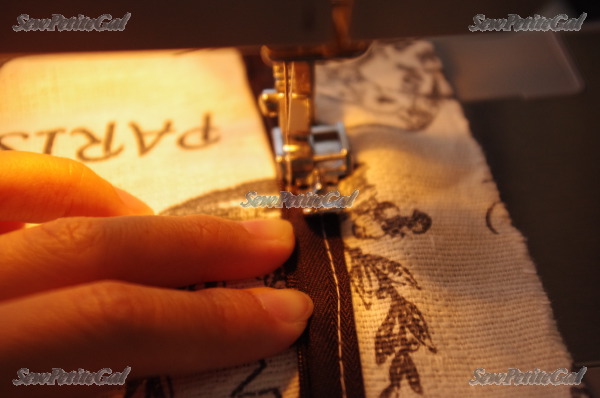Typical Zipper Lengths and Project Types:
- 7-9" = Skirts
- 12-14" = Side zips on dresses / tops
- 20-22" = Back zips on dresses / tops
I personally use the 7-9" and 20-22" sizes the most. Though side zips are nice in minimizing a zipper on the exterior, I find that the zipper tab bothers me throughout the day. I stock up on white, beige, and black zippers during every sale and find that those are really the only colors I need. I do also pick up odd colors on clearance (sale goggles are applicable with sewing supplies too) and throw those in on occasion (like this leopard print with lilac zipper). Since you only see the zipper tab, even an out-there color doesn't matter too much.
Getting Started:
If you read the directions on the packaging, they advise you to iron the zipper first so that the area folded underneath the teeth is exposed and ready for sewing. In order for your zipper to be "invisible", you need to stitch right along this little groove (great pictures in the tutorials mentioned above). For whatever reason, I can never seem to iron to the point of it being completely exposed (might be the fear of accidentally burning my fingers or melting the zipper). So I forgo the ironing and move right along.
What I do:
1.) Unzip the zipper and align one side first. I place the zipper stop at where the top of my garment will be. Pin in place.
In the case of the skirt below, this is halfway up the length of the waistband.
2.) Baste one side.
3.) Close the zipper to align your other side by matching the waistband / skirt seams up.
4.) Baste the other side. Do not worry about basting these perfectly! As you can tell, I do these pretty quickly because the main purposes of basting are to allow for try-ons and test zipper positioning. In the event that the garment needs to be looser or tighter, you just need to tug the bobbin thread and the whole zipper will come off for easy realignment.
Quickly baste your zipper in to test garment fit and zipper positioning
5.) Once I'm happy with the positioning, I use a regular zipper foot (I tried one of those plastic invisible zipper foots once and could not get the stitching close enough for the zipper to be invisible) to stitch along the groove.
5a.) To do this, I use the wider part of the foot base to push the teeth down and my fingers to expose the groove while I slowly stitch my way down. Caution - be very aware of of where your fingers are in relation to the needle!
Once complete, you can remove the basting if you'd like. I usually just keep it in since it doesn't affect anything and no one can see it in the interior.
True to its name, the zipper should be invisible when zipped
8.) Now time to close up the top of the zipper.
If you were to fold this over normally to stitch down, the top of the zipper tape might become exposed:
My Mom taught me to simply fold the fabric over the zipper and stitch closely along the teeth:
When you flip the fabric over, you'll see that both the excess fabric and top zipper tape are neatly enclosed:
Finished!
Exterior view of installed zipper - see the visible tab?
How the zipper looks from the interior
Questions? Please feel free to comment below, tweet me, or email me.






















